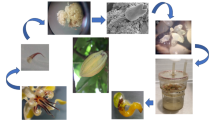Abstract
Cysts ofChattonella antiqua (Raphidophyceae) were obtained in laboratory cultures for the first time. They were formed on the surface of glass coverslips added to both P- and N- depleted mediums. The yield was 50–250 cysts cm−2. Crossing experiments showed the highest cyst production in mixed cultures, although cysts were observed in clonal cultures as well. Cysts had approximately double the DNA content of synchronously growing vegetative cells (G1 phase). The encystment process was also monitored: Under P-depleted conditions, ‘small cells’ were formed that fused to become a ‘triangle’-shaped cell which in turn changed into a cyst.
These results strongly suggest that cysts are the products of fusion and are diploid. ‘Small cells’, ‘triangle’-shaped cells, and cysts are considered to be gametes, planozygotes, and hypnozygotes, respectively. Significant mortality was observed in laboratory cysts stored in the cold and dark for five months, although those remaining were capable of germination to reestablish a motile, vegetative population.
Similar content being viewed by others
References
Anderson, D.M. and N.L. Lindquist (1985): Time course measurement of phosphorus depletion and cyst formation in the dinoflagellateGonyaulax tamarensis Labour. J. Exp. Mar. Biol. Ecol.,86, 1–13.
Anderson, D.M. and D. Wall (1978): The potential importance of benthic cysts ofGonyaulax tamarensis andGonyaulax excavata in initiating toxic dinoflagellate blooms in the Cape Cod region. J. Phycol.,14, 224–234.
Anderson, D.M., S.W. Chisholm and C.J. Watras (1983): Importance of life cycle events in the population dynamics ofGonyaulax tamarensis. Mar. Biol.,76, 179–189.
Anderson, D.M., D.W. Coats and M.A. Tyler (1985): Encystment of the dinoflagellateGyrodinium uncatenum: Temperature and nutrient effects. J. Phycol.,21, 200–206.
Anderson, D.M., D.M. Kulis and B.J. Binder (1984): Sexuality and cyst formation in the dinoflagellateGonyaulax tamarensis: Cyst yield in batch cultures. J. Phycol.,20, 418–425.
Binder, B.J. and D.M. Anderson (1987): Physiological and environmental control of germination inScrippsiella trochoidea (Dinophyceae) resting cysts. J. Phycol.,23, 99–107.
Cetta, C. and D.M. Anderson (1990): Cell cycle studies of the dinoflagellatesGonyaulax polyedra Stein andGyrodinium uncatenum Hulburt. J. Exp. Mar. Biol. Ecol.,135, 69–84.
Imai, I. and K. Itoh (1985): Distribution of dormant cells ofChattonella in bottom sediments of Harima-Nada, eastern Seto Inland Sea, in April, 1984. Bull. Nansei Reg. Fish. Res. Lab.,19, 43–52.
Imai, I. and K. Itoh (1986): A preliminary note on the cysts ofChattonella (Raphidophyceae), red tide flagellates, found in bottom sediment in Suo-Nada, western Seto Inland Sea, Japan. Bull. Plankt. Soc. Japan,33, 61–63.
Imai, I. and K. Itoh (1987): Annual life cycle ofChattonella spp., causative flagellates of noxious red tides in the Inland Sea of Japan. Mar. Biol.,94, 287–292.
Imai, I. and K. Itoh (1988): Cysts ofChattonella antiqua andC. marina (Raphidophyceae) in sediments of the Inland Sea of Japan. Bull. Plankt. Soc. Japan,35, 35–44.
Imai, I., K. Itoh and M. Anraku (1984): Distribution of dormant cells ofChattonella in Harima-Nada, eastern Seto Inland Sea, and temperature characteristics of germination. Bull. Plankt. Soc. Japan,31, 35–42.
Imai, I., K. Itoh, K. Terada and M. Kamizono (1986): Distribution of dormant cells ofChattonella (Raphidophyceae) and occurrence of summer red tide in Suo-Nada, western Seto Inland Sea. Bull. Jap. Soc. Sci. Fish.,52, 1665–1671.
Nakamura, Y. and M.M. Watanabe (1983): Growth characteristics ofChattonella antiqua Part 2. Effects of nutrients on growth. J. Oceanogr. Soc. Japan,39, 151–155.
Nakamura, Y., T. Umemori and M. Watanabe (1989): Chemical environment for red tides due toChattonella antiqua Part 2. Daily monitoring of marine environment throughout the outbreak period. J. Oceanogr. Soc. Japan,45, 102–113.
Nemoto, Y., T. Kuroiwa and M. Furuya (1987): Photocontrol of nuclear DNA replication inChattonella antiqua (Raphidophyceae). Plant Cell Physiol.,28, 1043–1049.
Ono, C. and H. Takano (1980):Chattonella antiqua (Hada) comb. nov., and its occurrence on the Japanese coast. Bull. Tokai. Reg. Fish. Res. Lab.,102, 93–100.
Pfiester, O.P. (1975): Sexual reproduction ofPeridinium cinctum f.ovoplanum (Dinophyceae). J. Phycol.,11, 259–265.
Subrahmanyan, R. (1954): On the life-history and ecology ofHornellio marina gen., et sp. nov. (Chloromonadineae), causing green discoloration of the sea and mortality among marine organisms off the Malabar coast. Indian J. Fish.,1, 182–203.
Wall, D. (1975): Taxonomy and cysts of red tide dinoflagellates. pp. 249–256.In: Toxic dinoflagellate blooms, ed. by V.R. LoCicero, Proc. intl. conf. (1st). Mass. Science and Technol. Found.
Author information
Authors and Affiliations
Rights and permissions
About this article
Cite this article
Nakamura, Y., Umemori, T., Watanabe, M. et al. Encystment ofChattonella antiqua in laboratory cultures. Journal of the Oceanographical Society of Japan 46, 35–43 (1990). https://doi.org/10.1007/BF02124813
Received:
Revised:
Accepted:
Issue Date:
DOI: https://doi.org/10.1007/BF02124813




